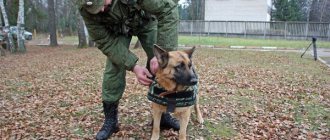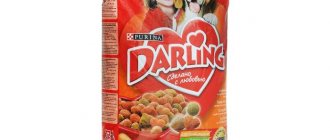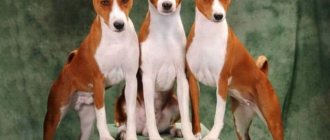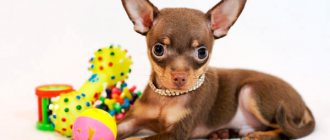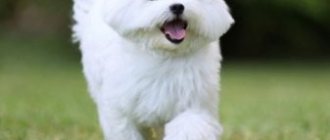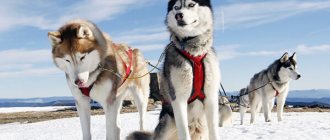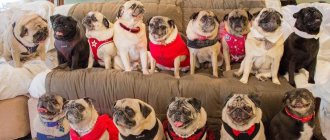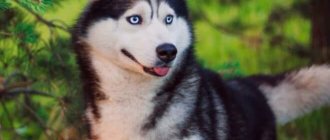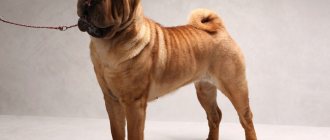- Description of the breed
- Photo
- Nurseries
- Lifespan: 10-18 years
- Weight: 4-7 kg
- Height (height at withers): up to 27 cm
- Puppy price: pet class – 15-25, breed class – from 30, show class – from 45 thousand rubles. and higher
The Shih Tzu is a decorative dog with a beautiful double coat. Charming, cheerful and very sociable breed, a true companion for the whole family.
In the review: a detailed description of the breed with photos, character traits, features of caring for the dog. Popular haircuts with photos. At the end there is a list of kennels for purchasing a puppy.
Origin of the breed
Legend has it that one of the first Shih Tzus was Buddha's pet. At night he slept next to the saint, during the day he ran after him and entertained him with games, and if he was in danger, he turned into a formidable lion and drove away his enemies with a roar.
The first official documents mentioning the breed date back to the 17th century, when the then Dalai Lama presented several puppies to the Emperor of China. Since then, for several centuries it has been forbidden to mere mortals and was considered the property of the imperial family. Only at the end of the 19th century did it become known to the world and came to Europe.
The first club was created in 1933, and the first standard was adopted in 1948. The name of the breed is literally translated from Chinese as “lion cub” and is written in two characters: 獅子.
Breed standard and description
The parameters of an ideal representative are determined by the standard, revised and approved in the middle of the 20th century:
- Height up to 27 cm, weight up to 8 kg. Bitches are only slightly smaller than males.
- The head is round and wide, the muzzle is somewhat shortened, without wrinkles. The fur on it grows abundantly, on the lower jaw there is a mustache and beard, which grow noticeably if the dog is not trimmed. On the bridge of the nose, the hair grows straight up, resulting in the appearance of a flower. Should not interfere with the dog's vision.
- The eyes are widely spaced, slightly protruding, their color is always dark, the white is not visible. Large, but in proportion to the head.
- The nose is black, the tip of the nose is in line with the lower edge of the eyelid. The nostrils are wide open, the nose itself is either straight or upturned, the transition from the forehead to the nose is pronounced.
- The lips fit tightly to the jaw, and the jaw has either a pincer bite or a straight bite - in any case, the lower one is slightly pushed forward.
- The ears are large, hanging, located just below the top of the head. The fur on them is long and blends in with the rest of the coat, which is why you can’t really see the ears.
- The neck is proportional and holds the head proudly.
- The body is elongated, the back is straight.
- The tail is luxuriously feathered, carried high and set high, giving the dog a balanced appearance - the bushy tail balances the fluffy head.
- The paws are short and straight, abundantly covered with hair.
Movements are smooth and easy. The dog does not run too fast and is not very resilient, but the pushes with its hind legs are strong, and its front legs move widely and softly. Able to jump onto high obstacles relative to overall height.
Colors from photos
The standard is very democratic when it comes to colors. Any variants are allowed for breeding and competition, and they have a lot of colors:
- White with gold. Any light red color combined with white. The standard does not determine which of them should predominate and which should be spots, therefore any dogs with this combination are considered excellent representatives and potential champions.
- Tricolor. Very rare. In it, a small amount of dark hairs is added to gold and white, which gives the appearance expressiveness. Sometimes in the pedigree the breeder calls the sable color tricolor in order to sell the puppy at a higher price.
- Sable. Occurs more often. The white and gold ones have black trimmed tips, but the hairs themselves are always one of the light colors.
- Black and white. The second most common, after white and gold.
- Red and white. On the same frequency as black and white.
- Gold with black mask. Third most common. The dog is of a uniform shade, only with a black mask on its face.
- Red with black mask. On par with gold.
- Black. Also on the same level in frequency as colors that have masks. The pigmentation is rich, black color without reddish impurities.
In all colors, except solid, it is desirable to have white feathering on the tail.
Interestingly, in addition to the most common ones, there are other colors, and all of them are part of the standard, all of them allow the animal to be nominated for the title of champion.
How long do they live?
Even by the standards of toy dogs, which live much longer than large dogs, Shih Tzus are long-lived. On average, their lifespan is 16 years, and with good care they can live up to 20.
Character and intelligence
The period when the Shih Tzu conquered Tibet was not in vain. Shepherds used a cute and smart dog to guard their livestock. Small weight and height did not become an obstacle to the manifestation of courage and bravery. When you get to know this breed better, you get the impression that the dog knows the concept of a “code of honor.” Her endless kindness to all living things quickly turns into decisive action if one of the household members is in danger. With no less zeal they will rush to protect the cat they grew up with.
Despite the display of such excellent traits, one must not forget that at their core, Shih Tzus are stubborn and proud. These qualities need to be directed in a constructive direction from childhood.
The Shih Tzu is sometimes called a “chrysanthemum” because of the direction of hair growth on its face. But you shouldn’t expect a cute character from a “flower” dog. She is freedom-loving and energetic, endowed with natural courage. These qualities, combined with her intelligence, help her easily take a leading position in the family.
How the pet will ultimately grow up, whether it will be a friend and companion or a demanding dictator, depends on the owner.
Attitude towards children and others
These pets subtly sense the psychological mood of people. They will not distract you from important matters or demand attention if they see that everyone is busy. But she herself is ready to express her good nature at any moment. If a new pet appears in the family, she will be the first to show interest in him and offer friendship.
A dog living in families with small children may suffer from the child's games. But she is not able to tolerate even the slightest neglect, not to mention pain. It is better to wait until the child grows up to buy a puppy.
For older children, dogs of this breed, on the contrary, will become ideal companions for games and active walks in the fresh air. Cheerful and inquisitive, they will enjoy exploring the world with teenagers.
Shih Tzu character
They were originally bred as companions, which is typical for most small dogs. This, as well as a kind of selection at the imperial court, left an imprint on their character and most of the traits remain unchanged to this day.
- love for people. All dogs love people, and for animals that were specially bred for this, this is natural. But these dogs stand out even against this background: they love absolutely all people more than any other animals and even more than dogs. They love their family. Selflessly devoted to the owner. They happily allow themselves to be stroked even by passers-by on the street, which is unthinkable for any guard or service dog.
- need for attention. These are very sociable dogs that cannot stand being alone. No one left their ancestors unattended or raised them alone: they were cared for and cherished, and they always had someone to play with. Therefore, modern representatives of the breed suffer if they are given insufficient attention. And that is why they are not recommended for single people who work 12 hours a day. The dog will feel sad if left without company for a long time, and this will have a detrimental effect on its psyche.
- empathy. All dogs sense a person’s mood to one degree or another. This comes naturally to them: they are social animals, just like people. But in companions this ability is especially well expressed: they will not help if a person is busy or angry, but they will come to console him if he is upset, and will gladly join in the fun if he is in a good mood. They are recommended as companions for elderly and sick people - it has been scientifically proven that the presence of a dog, which worries about a person’s condition and can distract from gloomy thoughts or pain, has a beneficial effect on well-being.
- optimism. These are agile, active, cheerful dogs that play with pleasure, never lose heart and are always ready to participate in any undertaking of the owner. For a pet to feel sad, something really serious must happen.
The combination of traits results in a cute, cheerful dog who doesn't really match his own arrogant appearance. It’s a pleasure to spend time with him and he will be an excellent companion for the whole family, since he will not single out one owner.
Pros and cons of the breed
This character, of course, has its advantages:
- It's nice to spend time with the dog. He is cheerful, sweet, handsome, he will not allow you to be sad and bored, and will gladly take part in any interesting activity.
- His presence has a beneficial effect on sick and old people. Watching the dog play makes it easier for them to cope with problems.
- He doesn't need a lot of activity. Of course, you need to walk him, like any other dog, but you can do this at a leisurely pace for about an hour, rather than running through the surrounding fields for three hours. Elderly pets prefer to bask in the sun somewhere in the yard, next to their owner, than to trudge somewhere on foot.
- He is smart and enjoys learning new tricks.
And besides, he looks lovely: a trimmed, well-groomed dog looks like an exotic flower that has suddenly grown legs and is now experiencing an all-consuming delight about the world around him.
But there are also disadvantages:
- Gullibility. Dogs are absolutely not afraid of strangers and it is simply impossible to explain to them the concept of reasonable caution. A representative of the breed cannot be turned into a guard and it is better not to leave him alone, for example, near a store. He won't be able to defend himself.
- Jealousy. They love people and attention to themselves very much, so they can be jealous. A new animal or, especially, a child will cause stress in the pet and attempts to return everything to normal. It is important to remember this and stop such behavior in time, devoting more time to the person offended by inattention than usual.
- Need for company. You cannot systematically leave him alone for a long time. Of course, if the owner has an emergency and urgently needs to leave, the dog will wait and not die. But if long absences are constant, this will negatively affect the psyche, he will become capricious, disobedient and aggressive. Most behavioral problems come from a lack of communication.
In addition, the Shih Tzu requires constant care, which requires effort. The fur looks good and beautiful only if it is washed and combed, and also trimmed.
But as a result, the dog looks like a real miracle.
Characteristics: pros and cons
Let's discuss the pros and cons in a detailed description of the breed:
Due to the high carriage of the head and tail, the dogs look proud and mannered
Shitzus are proud not only on the outside, but also on the inside! Remember the narcissistic character inherited from your ancestors, after all, the imperial dog! Loves attention and respect. This baby will not tolerate neglect, so it is not recommended to adopt this breed if there are small children at home. They treat older children well, because
The dogs are very active and love to play. According to RKF standards, dogs are attentive, intelligent, friendly, and active. But despite all this, they are independent. Cowardly and aggressive dogs are disqualified.
In the family they do not choose a favorite. A big plus of the Shih Tzu is that they treat and become attached to all family members equally. If you do not have time to communicate with your pet, then it is better not to adopt a Shih Tzu. They love communication, attention, and if they are left at home alone, they are very bored.
Cats in the house are treated neutrally, and they do not show aggression towards any other pets. These dogs are well suited for older people, it is not for nothing that they were classified by the RKF in the group of companion dogs. They will always be nearby, carefully observing the mood of the owner. If they notice that the owner is sad, they will try to cheer him up. Many dogs can walk on their hind legs. In general, dogs are people-oriented; people are more interesting to them than other dogs. They react to human speech and are smart. Well trained, because have a good memory. Of course, the defenders of these small creatures, due to their size, are so-so; many specimens rarely even bark. However, there are also loudly barking puppies that will signal any attack on your home. If the genetic memory of a shepherd dog has awakened, then they can start barking and biting their household members on the legs. All this can be easily fixed if you not only take care of the puppy, but also educate him.
Care and maintenance
Grooming will require time and effort, since the coat is long and constantly needs to be washed, trimmed, or combed. Besides:
- Brush your teeth with a small brush once a day. Small animals are prone to the formation of tartar, so the procedure is mandatory.
- Trim nails once every two weeks. If necessary, more often. Since pets usually spend most of their time in the apartment, their claws do not have time to wear down.
- Check your ears. As with any breed with floppy ears, there is a tendency to get ear infections. Therefore, once every two days they look into the ears, remove excess dirt and wax, and sprinkle them with special powder, which removes moisture.
- Walks. They walk for two hours a day, morning and evening. It is important that the walk is filled with interesting experiences: Shih Tzus are good for exploring unfamiliar areas, meeting other dogs and playing ball. The main thing is not to overdo it and not tire the animal. Still, it does not differ in great endurance.
You also need to remember about proper nutrition and protection from stress. Shih Tzus are not overly nervous, especially for a small breed, but still, due to their trusting and sensitive nature, many things can frighten or upset them. The owner’s concern is to smooth out the consequences.
Grooming
Grooming is an important part of caring for the breed. Trimmed, combed and washed, it becomes very soft, pleasant to the touch and beautiful.
Need to:
- Wash. Every week and a half, using special dog shampoos that do not wash off the fat layer and are not harmful to health. They teach the puppy to wash himself, wash him right in the bathroom, placing him on a rug or towel so that his paws do not slip. After washing, dry with a towel, and then dry with a hairdryer so that the wool lays down well.
- Combing. Brush every day until the coat is soft, silky and tangle-free. To make the process easier, use conditioner or special foams.
And, of course, the Shih Tzu gets a haircut. In the summer, this is necessary so that the dog does not suffer from the heat, and in other seasons, at least a hygienic haircut is carried out.
Eye care
There is a tendency to eye diseases, so you watch your eyes carefully, checking them every morning and wiping them with a damp cotton swab to remove any discharge. And so that the dog does not suffer from the fact that nothing is visible around, the hair around the eyes is carefully trimmed with scissors, so that it does not fit into them. And, if the haircut involves bangs, pin them up so that they do not interfere with the field of view.
If the eyes are watery, red, changed color or swollen, contact the veterinarian: this could be a manifestation of conjunctivitis or even something more serious. Read more about the causes of red eyes.
Health and illness
Unfortunately, nature is not perfect. The little imperial “lion cub” can get sick not only when care and maintenance are improperly organized, but also due to its genetic and anatomical characteristics:
- Proptosis, or dislocation of the eyeball. The fact is that it is held in place only by the masticatory muscle, so even slight pressure (trauma) can cause prolapse. More often this happens in dogs with congenital underdevelopment of the fundus. Under no circumstances should you try to correct a dislocation on your own. The wound must be wiped with a bandage soaked in cold water, the eyes should be generously smeared with any eye ointment, and the dog should be immediately taken to the veterinarian. Treatment is only surgical. The outcome depends on many factors. The chances of saving vision are close to zero if this is not the first case of proptosis.
- The dog has another unpleasant anatomical feature - small jaws. Teeth develop poorly, can become crooked and even fall out. Sometimes signs of periodontal disease appear. Gums bleed, teeth become loose. If you monitor your pet's health and visit the veterinarian regularly, dental disease can be stopped at the very beginning.
- Spinal diseases can accompany an “aged” dog. Therefore, older animals are not allowed to often move up steps or jump on heights. If you notice a problem with your back, you should immediately contact a veterinarian so as not to lead to partial immobilization.
The health of a pet primarily depends on proper care and care from the owner. You need to take into account your predisposition to various diseases and know how to act in a given situation. The success of treatment largely depends on the correct actions of the owner. Before purchasing a pet, you need to find out everything about the Shih Tzu: breed, anatomical features, genetic predisposition.
Important! When adopting a purebred dog into your family, you need to have in your notebook the phone number of a good veterinarian who is ready to provide assistance at any time of the day.
Lifespan
A Shih Tzu can live a relatively long canine life if you provide it with a good diet, a warm home, regular walks and keep its mouth clean. The average lifespan of the breed is 12 -16 years. However, it is not uncommon for a beloved pet to live for more than 20 years.
How long do Shih Tzus live by human standards? You need to multiply the age of the Shih Tzu by 6. That is, a ten-year-old “lion cub” is actually already 60 and care should be appropriate. In the diet, increase the amount of food containing calcium.
The number of active walks should be gradually reduced to reduce the load on the heart. However, you can’t give up walking completely.
Important! The older the pet, the more often you should visit the veterinarian, without waiting for signs of deterioration in health.
Types of Shih Tzu haircuts with photos
The big plus and big minus of the Shih Tzu breed is that they constantly need a haircut. On the one hand, this is a waste of time, effort and money. On the other hand, it’s an opportunity to try something new and learn something. After all, professional hairdressing services are truly needed only for show dogs, who must look perfect.
A pet that only pleases the family is often trimmed independently, using, as an example, one of the popular haircuts:
- "Puppy". All fur is trimmed evenly, to about 2.5 cm, the muzzle is made round and cute, with even ears and almost no mustache or beard. The top of the head is cut into the shape of a beret.
- "Teddy bear". The hair on the body is cut to the same 2.5 cm, the muzzle is cut shorter than that of a “puppy”, making it completely round. The paws are left longer, about 3.5 cm, which gives the dog a resemblance to a plush toy.
- Classic exhibition. Suitable for those owners who like to tinker with wool and do hairstyles, since the length is left at the usual length. But they trim the ends so that they look neat, trim the hair on the paws between the toes, at the anus, at the eyes and mouth so that it does not interfere with the dog - this is called a “hygienic haircut.” And from the wool that remains long, they make braids, attach bows to it, pin it and comb it.
- "A lion". This is how male dogs are cut more often. The fur on the body is 2.5 cm long, there is a fluffy tassel on the tail, and a long mane around the neck and chest. It looks extremely impressive.
And, of course, you can always experiment with the appearance of your pet. Choose interesting accessories for him, dye his wool, visit hairdressers, select suits.
Dogs are calm about this kind of experimentation - for them it’s just another way of interacting with their owner.
How to choose a puppy?
The breed has been very popular in recent years, so many people who are ignorant in this matter are breeding it and claim that they “know everything about Shih Tzu.” As a result, the market is filled with unbalanced individuals who are difficult to train, grow up aggressive, and have low intelligence. You won’t be able to buy purebred Shih Tzu at a cheap price from unknown “breeders.”
Signs that indicate an unscrupulous approach by breeders to breeding dogs:
- the sullen, unfriendly appearance of the puppy;
- disproportionately large belly;
- tail between legs;
- untidy appearance of the baby and his mother.
If they offer dwarf Shih Tzus, it means that the seller simply has a failed specimen in his hands. To understand what to expect from a puppy, you need to visit the kennel and look at its parents. In dirty kennels, dogs are not taught hygiene procedures from childhood. It will be very difficult to do this later. Buying such an animal will bring problems.
The best age to purchase a pet is 2.5 months. There must be a veterinary passport with notes on vaccinations given. If you plan to take them to exhibitions (show class), you need to pay attention to six-month-old individuals. At this age, all the show potential is revealed: fur, teeth, body structure and other anatomical features.
A purebred Shih Tzu puppy must have a strong build, a straight, elastic back, thick and at the same time pliable hair, the brand must match the entry in the metric.
Currently, dogs of this breed are bred in more than 80 nurseries in the country.
What to feed and how much
Proper nutrition is the key to a long and happy life. A common option is natural food that is prepared for the dog right at home. The main thing is not to get carried away and remember that his body is not human and that what family members calmly digest, he will not assimilate.
It is recommended to cook lean, boneless meat, porridge with meat broth (rice and buckwheat), and cook vegetables (zucchini, pumpkin, carrots, bell peppers). Give dried offal and small pieces of fruit as treats. Sometimes add vegetable oil to the food or treat the dog with half a boiled egg.
You can’t give fatty, salty, spicy, sweet foods. Even if your pet begs from the table and looks with soulful, pitiful eyes, you should not treat him even with small pieces.
You can’t eat cheese, you can’t eat vegetables that cause gas, you can’t eat strawberries, citrus fruits, or chocolate. But you can eat fish, but not often, in small quantities and always without bones.
Dry food
Dry food is recommended by veterinarians. Firstly, it is more difficult to make a mistake with the dosage, and secondly, there is a tendency to food allergies and it is easier to ensure proper nutrition by using balanced food for allergy sufferers.
The recommended brands are Pro Plan, Royal Canin, Akana, First Choice. It is important to look at the dog’s reaction: does it like it, does it eat with appetite, does it have diarrhea or constipation. Even the best and most popular food may not be suitable for a particular animal and it is important to take this into account.
Education and training
Like all companions, Shih Tzus are wonderful learners who enjoy teaching commands and receiving praise and admiration. They are often recommended to inexperienced dog owners and people with a gentle character: in order to teach such a child something, you need to correctly combine affection and encouragement, and it is quite difficult to spoil something.
There are only two mistakes that owners usually make:
- Impunity. Shih Tzus are very small and very cute dogs. Yielding to their charm, a person is not always able to soberly assess what is happening. It seems that one piece from the table, one permission to climb onto the sofa and sleep there, one permission to ignore the command is nothing to worry about, it will be corrected later. But as a result, the pet quickly understands how charm affects people and begins to use it to receive treats, strokes and avoid punishment.
- Too strict upbringing. The opposite of lack of education is excessive severity. People who are used to large dogs or have read extremely harsh advice can easily become overwhelmed by a small pet. A rude shout, tugging on a leash, holding someone by the scruff of the neck - all these are ways of working with service dogs. And they can significantly damage the psyche of a decorative companion.
If a dog behaves the way he wants, ignores commands, pulls on the leash while walking, steals food from the table, climbs onto the sofa at any time and does not listen to the owner, this means that he has been completely spoiled.
If he does not immediately respond to calls, flinches at the sound of a voice, spends most of his time alone, gets confused in commands and urinates in the wrong places at the wrong time, this means that he has been completely bullied.
The path of proper education passes between these two extremes. Need to:
- Make the rules clear. What is not allowed is always not possible, otherwise a smart dog will quickly understand when the owner is ready to take liberties and begin to take advantage of it. Or switch to weaker family members or guests. Education must be constant and coordinated. If you can't beg from the table, then no one should encourage such behavior.
- Get the puppy interested. The first commands are taught as early as the baby, and therefore the process should be fun and interesting. Treats should be one bite at a time, alternate with praise and petting. Don't punish, just calmly discipline. When your attention begins to wander - and this will happen quickly - take a break and then repeat again. It is better to start with the commands “place”, “lie down”, “sit”, “fetch” and only then move on to complex and sometimes unpleasant ones.
- Give enough time and attention to the puppy. Most behavior problems stem from restlessness and loneliness. Therefore, you need to constantly take the puppy with you, exercise, play with him, so that he either eats, or plays and learns, or sleeps. Excess free time will only harm him.
A happy puppy is obedient, always happy to receive attention, and loves to learn. You can learn tricks with it: teach you to find an object hidden in a room, open a closet drawer, look for a hidden person, fall on your side and close your eyes when you see a “gun” pointed at your chest from your fingers. Commands are tied to words, gestures or clickers, and they are rewarded for correct execution.
The only command that requires rigor to learn is “fu,” on which the dog’s safety depends.
You need to start training exactly from the moment the puppy gets to its new home.
Key points in training
Decorative breeds do not need training as much as they need education. The Shih Tzu is a wayward dog, sometimes stubborn, and difficult to train. But if you take care of your puppy from childhood, you can raise an easy-going and obedient pet.
Read about how to properly train a dog in the article: “Training a puppy: effective methods from dog handlers, learning commands at home.”
You cannot scold, offend, or beat a dog. For punishment, a strict intonation, a look, or deprivation of a treat will suffice. These dogs cannot live without attention, so ignoring can be used as a reprimand.
Your pet needs to remember a few rules. He should not beg, be stubborn, or ask for food until the owner and family have finished eating. You can enter the house only after a person, jump and sleep on furniture after permission.
Diseases in the breed
Decorative dogs are very popular, and therefore their breeding is not always done professionally enough and over time, debris accumulates in the genes. For example, susceptibility to certain diseases:
- Food allergies. Dogs have sensitive stomachs, and they often have allergic reactions to relatively harmless irritants. This problem is solved by selecting special food for allergy sufferers.
- Cataract. It develops quite often in old age. The lens in the eye becomes cloudy, the dog begins to navigate worse and gradually loses vision. The problem is solved by surgery.
- Turn of the century. It can be solved by surgery, but puppies diagnosed with the disease are not bred.
- Urolithiasis disease. Indirectly related to the sensitivity of the gastrointestinal tract: with poor nutrition, stones form in the kidneys, which cause severe pain and spoil the quality of life. The matter is solved by surgery, and then by a special diet, which contains almost no salt, for example.
- Chronic heart valve defects. You can live a long, happy life with a heart defect, but only if the owner does not unnecessarily burden the dog, does not allow it to develop excess weight, and feeds it properly. Sick dogs are more sensitive to physical activity and have a risk of thrombosis, so the amount of fat in their food is even lower than that of healthy dogs.
- Tracheal collapse. A congenital condition in which the trachea is stiffer and less mobile than normal. As a result, the air passes through it worse, and as soon as the dog gets nervous, it begins to choke. Doctors prescribe relaxing and anti-spasm drugs to such patients.
There are also problems with joints, so dogs are not recommended to jump from any height. It is advisable that the owners teach the puppy from childhood that he should not climb onto the sofa, chairs, or bed, and should move up the stairs slowly and at his own pace.
Prevention allows you to avoid most problems.
Characteristic
The unusual nature of these dogs is manifested primarily in the presence of long hair. Let's look at all the features of the Shih Tzu in a detailed description of the breed.
Main settings
Shih Tzus are short dogs, their height is 27 cm at the withers. For all their weightless appearance, they are actually far from “fluffy” - the weight of individuals can vary from 4.5 to 8.1 kg, but according to the standard, it is desirable that it be no more than 7.5 kg. The long hair of these dogs does not curl at all, and they also do not have a fluffy undercoat, so their “hair” looks smooth and impressive.
Head
The dogs' black doll eyes are spaced quite far from each other. The muzzle is characterized by abundant vegetation - in addition to the general covering, there are antennae and a beard. The ears of these dogs are set low and hang down. According to the standard, the nostrils should be wide open, and the bridge of the nose should be upturned or straight. In general, looking at the Shih Tzu's face, one gets the impression that they have a slightly arrogant appearance.
Body
The body structure of dogs of this breed also has its own nuances. The Shih Tzu's chest is lowered and its shoulders are laid back. The paws have a slightly rounded shape. Dogs carry their tail over their back, which makes their appearance even more important. The hind legs push off well when running; in general, the dogs’ gait is smooth and somewhat “proud.”
TOP nicknames for Shih Tzu
They try to name it so that the name matches the description of the Shih Tzu, the regal appearance of the dog and the long history of the breed. However, it should not be too long and complex, otherwise it cannot be used in a hurry.
For boys
For male dogs, choose something in the spirit of the following nicknames: Lion, King, Lord, Count, Lay, Zen, Minj, Chan, Renshu, Happy, Star, Rich. Something monosyllabic and at the same time pretentious, meaning beautiful, rich, happy or magnificent in other languages.
For girls
For females, nicknames are also monosyllabic: Jessie, Molly, Beauty, Dezzy, Lucky, Cherry, Venus, Chloe, Adele, Ting, Ki, Hang, Xia, Ning, Ju. These are either female names, or the same beautiful, calm, magnificent in other languages. You can even call the dog Ruolan, which means “Orchid” in Chinese.
Nicknames for boys and girls: what to call
If a puppy has a pedigree and is taken from a kennel, then the official nickname is given in the kennel by the breeder and this choice is subject to the rules of the RKF. This nickname cannot be changed. All nicknames are registered, and the nickname can be used in the nursery once every 30 years. In one litter, all puppies' names begin with the same letter.
Many owners then come up with a “pet” nickname for their pet. They shorten the official nickname or select a completely new one. Some focus on the meaning of the word, some name the dog after someone, and many simply choose the name they like. In any case, this name should be short, simple and euphonious.
- Popular names for boys: Archie, Chucky, Barney, Spikey, Bucks, Dobie, Gray, Umka, Tima, Smile, Jacques, Toby, Scooby, Messi, Troy.
- For girls: Bonya, Molly, Cassie, Laima, Vesta, Bessie, Beauty, Keri, Alba, Moska, Chelsea, Adele, Masya, Fanny, Lucky.

